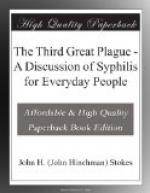+The Necessity for Legal Control.+—All these repulsive details have a place in driving home a conception of the cost to society of the immoral and irresponsible syphilitic. Syphilis is an infectious disease, dangerous to the individual and to society. If it is rational to quarantine a mouth and throat full of diphtheria germs, it is rational to quarantine a mouth and throat full of syphilitic germs at least until the germs are killed off for the time being. There can be no more excuse for placing society at the mercy of the one than of the other.
+The Morbid Attitude of Mind: Syphilophobia.+—The morbid attitude of mind, whether in persons who have the disease or in those who fear they may have it, is one of the hardest the physician has to deal with. Any one who knows anything of the disease naturally has a healthy desire to avoid it, and if he is a victim of it, a considerable belief in its seriousness. But certain types of persons, who are usually predisposed to it by a nervous makeup, or who have a tendency to brood over things, or who perhaps have heard some needlessly dreadful presentation of the facts, become the victims of an actual mental disorder, a temporary unbalancing of their point of view. To the victims of syphilophobia, as this condition is called, syphilis fills the whole horizon. If they have not been too seriously disturbed by the idea, a simple statement of the facts does wonders toward relieving their minds. A few of them cling with the greatest tenacity to the most absurd notions. For those victims of the disease who are the prey of morbid anxiety the assurance that it is one of the most curable of all the serious diseases, and that if they are persistent and determined to get well, they can scarcely help doing so, usually sets their minds at rest. The idea that there is a cloud of disgrace over the whole subject, and the old-fashioned belief that syphilis is incurable and hopeless, inflict needless torture and may do serious damage to the highly organized sensitive spirits which it is to society’s best interest to conserve. The overconscientious syphilitic hardly realizes that the real horrors of the disease are usually the rewards of indifference rather than overanxiety. Persons who subject themselves to the ordinary risks of infection which have been described in the preceding chapters do well to be on their guard and to maintain even a somewhat exaggerated caution. Those who do not expose themselves need not look upon the disease with morbid anxiety or alarm. In the




